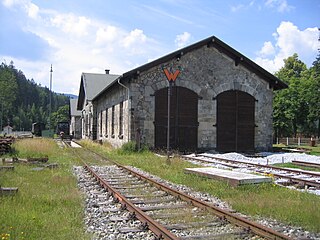Stahlbahnwerke Freudenstein is a defunct German railway company.
Stahlbahnwerke Freudenstein is a defunct German railway company.

The company was founded in 1891 by the merchant Julius Freudenstein; until then, Freudenstein had worked for Orenstein & Koppel. Originally, the company traded in track and materials for railways.
In 1895, Freudenstein acquired a small manufacturing facility in Tempelhof, Berlin for the construction of its own locomotives. At the same time, the company became a limited company.
The production of the company's own locomotives was only a stopgap, that was without great success, even with an order for Prussian state railway supplies. In 1905, Freudenstein merged with Orenstein & Koppel. This led shortly afterward to liquidation and closure of Freudenstein's plant at Tempelhof.
The last definite works number is FNr.238, built in 1905.
It is currently not known the exact number of locomotives that were built by Freudenstein, but it is estimated to be approximately 250, 5 are known to be preserved:
| Number/Name | Year Built | Gauge | Notes |
|---|---|---|---|
| 73 Berlin | 1901 | 610 | Built for Arthur Koppel, for use at Penlee Quarry. Now on Static display at Leighton Buzzard Narrow Gauge Railway |
| 89 | 1902 | 1435 | Transport rail & Museum Association, Aumühle. Originally supplied to Prussian state railway |
| 138 | 1904 | 1000 | Museo del Ferrocarril, Ponferrada |
| 175 | 1904 | 508 | Rail Transport Museum, Western Australia, Perth |
| 217 | 1905 | 518 | Bowylie Light Railway, NSW (Formerly ran at Bennett Brook Railway, WA 1989 - 1993) |

Orenstein & Koppel was a major German engineering company specialising in railway vehicles, escalators, and heavy equipment. It was founded on April 1, 1876, in Berlin by Benno Orenstein and Arthur Koppel.

The majority of Indonesia's railways are on Java, used for both passenger and freight transport. There are three noncontinuous railway networks in Sumatra while two new networks are being developed in Kalimantan and Sulawesi. Indonesia has finalized its plan for a national railway network recently. According to the plan, 3,200 km of train tracks that will criss-cross the islands of Sumatra, Java, Kalimantan, and Sulawesi, it has been touted as the most extensive railway project in Indonesia since its independence from the Dutch in 1945. Indonesia targets to extend the national railway network to 10,524 kilometres by 2030. As of September 2022, the network spans 7,032km.

The National Rail Museum in Chanakyapuri, New Delhi, displays exhibits on the history of rail transport in India. The museum was inaugurated on 1 February 1977. The museum spans over an area of over 11 acres and the indoor gallery comprises an octagonal building which houses six display galleries and a large open area is laid out to simulate the atmosphere of a railway yard. It is open every day except Mondays and national holidays.

The Efteling Steam Train Company is a 600 mm narrow gauge passenger railway line at the Efteling theme park, in the Netherlands.

The Buenos Aires Midland Railway (BAM) was a British-owned railway company which operated in Argentina, where it was known as Ferrocarril Midland de Buenos Aires. The company built and operated the 1,000 mm gauge line between Puente Alsina and Carhué in Buenos Aires Province.

A Mocăniță is a narrow-gauge railway in Romania, most notably in Maramureș, Transylvania, and Bukovina. Archetypically, they are situated in mountainous areas and the locomotives operating on them are steam-powered. These railways were built for cargo and passenger services – some in the era of the Austro-Hungarian Empire, before 1918 – but fell into disrepair over the years. Some are now being rehabilitated for the purposes of tourism.
0-3-0 is a type of wheel arrangement for a monorail steam locomotive.

The Tramway de Pithiviers à Toury (TPT) was a 600 mm gauge railway in the Loiret department of France. It was built to carry sugar beet and was 80 kilometres (50 mi) long.
A Luttermöller axle is an unusual steam locomotive component. Steam locomotives with several axles or wheelsets connected to one another by coupling rods are not able to negotiate tight curves well. In order to assist such locomotives, the manager of the Orenstein & Koppel factory in Berlin, Dr. Luttermöller, built the axle system named after him.

The Bavarian Localbahn Society, with its headquarters in Tegernsee, is a society that is concerned with the history of the railways in Bavaria. Localbahn means 'branch line' and is mainly used in southern Germany and Austria in lieu of the usual term Nebenbahn. The BLV's objectives are the operation of historic trains and the collection of historically valuable railway items from Bavaria.

The South African Railways Class NG2 0-4-2ST of 1897 was a narrow-gauge steam locomotive from the pre-Union era in Transvaal.

The South African Railways Dock Shunter 0-4-0T of 1909 was a steam locomotive.

The South West African 2-8-0T of 1907 was a steam locomotive from the German South West Africa era.

The South West African 2-8-0 of 1911 was a steam locomotive from the German South West Africa era.
There have been narrow-gauge railways which used 1,000 mm, 750 mm and 600 mm gauges.

The O&K CSÉT Shunting Locomotives were a class of nine small Irish steam locomotives built in Berlin, Germany, by Orenstein & Koppel for shunting wagons of sugar beet at the three Irish Sugar Company factories in Mallow, Thurles and Tuam. They were delivered in two batches, with the first six arriving in 1934 and the last three in 1935. The 1934 batch was paid for by barter, using cattle as payment. Each factory received three locomotives, and numbered them independently, leading to each factory having a No. 1, a No. 2 and a No. 3. Each factory applied their own design of number onto the tanks, and in some cases, bufferbeams, of their respective locomotives.
The South West African 0-6-0T of 1911 was a steam locomotive from the German South West Africa era.

The Egyptian Salt and Soda Company Railway was a 33 miles (54 km) long narrow gauge railway with a gauge of 750 mm in Egypt.
The Purero-class (プレロ) locomotives were a group of steam tank locomotives with 2-6-2 wheel arrangement of used by the Chosen Government Railway (Sentetsu) in Korea. The "Pure" name came from the American naming system for steam locomotives, under which locomotives with 2-6-2 wheel arrangement were called "Prairie".

The Waro Limestone Scenic Reserve is a conservation area near Waro near Hikurangi, 16 kilometres (9.9 mi) north of Whangarei on the North Island of New Zealand.